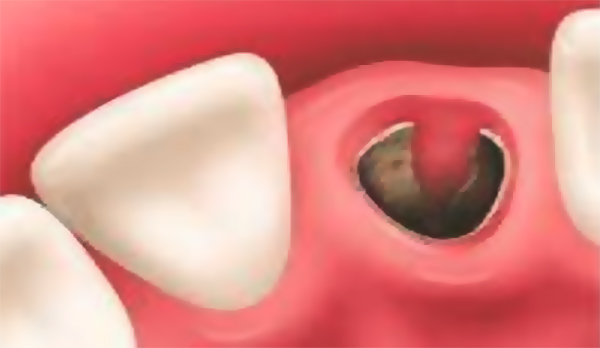What is a dry socket?
Dry socket is the condition that forms when the gum doesn’t heal properly after tooth extraction. If there are no issues after the removal, a blood clot forms in the place of the missing tooth and protects the nerves and bones, helping the gum recover. If this doesn’t happen, the nerves and bone remain exposed inside the mouth, causing what is known as dry socket.

Worried you may have a dry socket? Book an appointment now!
BOOK ONLINEHow to know if you have a dry socket?
Your dentist will warn you of the known factors which can cause a dry socket before the tooth extraction takes place and provide recommendations on how to avoid it. The easiest way to identify a problem following the removal is to monitor your pain. While certain discomfort is inevitable after the procedure, it should fade away in approximately three days. If the pain, however, increases, and there’s a growing sensitivity in the area of the tooth extraction, you should immediately book an appointment with your dentist.
Here’s a list of the factors, that will help you identify if you have a dry socket:
- bad taste in the mouth and foul smell;
- pain in the area of the extracted tooth, radiating to the ear, temple, neck, or even the eye on the side of the extracted tooth;
- exposed bone and lack of healing of the gums.
How to prevent a dry socket after tooth extraction?
While it is not completely clear what causes a dry socket, there are some factors which are related to the condition. To help prevent it, you can follow the below instructions:
- stop smoking at least 24h before, and a minimum of 48h after the procedure;
- stop chewing tobacco or any other substances;
- avoid oral contraception or any oestrogen-based therapy;
- ensure perfect oral hygiene;
- avoid using a straw for drinking after the extraction (the vacuum created in the mouth may remove the blood clot);
- chewing on the side of the extracted tooth.
Despite following the above instructions along with the ones provided by their dentist, some people may still develop a dry socket due to genetic predisposition. If you have had the condition in the past, make sure you inform the clinician performing your extraction and have a follow-up appointment scheduled for review of the gum.

Treatment of dry socket
The treatment of a dry socket consists mostly of pain management and ensuring clean from bacteria environment to allow the gum to heal properly. If you’ve developed a dry socket or feel pain more than three days after the extraction, immediately book an appointment with your dentist.
During your review, your dentist will sanitise the area of the tooth extraction and ensure there are no remains of the extracted tooth. They will apply medication to help the gums heal faster and prescribe pain medication and cleaning product following the treatment.
Make sure you take your medication strictly following the prescription of your dentist and do not miss any following appointments. Needless to say, you should be very careful when brushing the area around the dry socket and avoid any foods which may additionally irritate the gums.
During the treatment of a dry socket, ensure that:
- you drink plenty of water;
- you strictly avoid carbonated drinks;
- you don’t smoke or chew tobacco;
- you don’t use a straw for drinking;
- use chilled pads on the cheek of the extraction to reduce swelling;
- rinse very gently with warm water (or any prescribed mouth wash) several times a day;
- follow strict oral hygiene.

